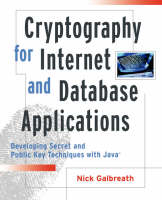
Cryptography for Internet and Database Applications
Developing Secret and Public Key Techniques with Java
Seiten
2002
John Wiley & Sons Inc (Verlag)
978-0-471-21029-0 (ISBN)
John Wiley & Sons Inc (Verlag)
978-0-471-21029-0 (ISBN)
- Titel ist leider vergriffen;
keine Neuauflage - Artikel merken
Groundbreaking coverage of the use of cryptography for securing databases. Cryptography is traditionally concerned with securing the transmission of data. Although the transmission is secure, unfortunately, the database is not and Internet theft of credit cards and other personal information is on the rise.
Cryptography is the gold standard for security. It is used to protect the transmission and storage of data between two parties by encrypting it into an unreadable format. Cryptography has enabled the first wave of secure transmissions, which has helped fuel the growth of transactions like shopping, banking, and finance over the world's biggest public network, the Internet. Many Internet applications such as e-mail, databases, and browsers store a tremendous amount of personal and financial information, but frequently the data is left unprotected. Traditional network security is frequently less effective at preventing hackers from accessing this data. For instance, once-private databases are now completely exposed on the Internet. It turns out that getting to the database that holds millions of credit card numbers-the transmission-is secure through the use of cryptography, but the database itself isn't, fueling the rise of credit card information theft. A paradigm shift is now under way for cryptography. The only way to make data secure in any application that runs over the Internet is to use secret (also known as private) key cryptography.
The current security methods focus on securing Internet applications using public keys techniques that are no longer effective. In this groundbreaking book, noted security expert Nick Galbreath provides specific implementation guidelines and code examples to secure database and Web-based applications to prevent theft of sensitive information from hackers and internal misuse.
Cryptography is the gold standard for security. It is used to protect the transmission and storage of data between two parties by encrypting it into an unreadable format. Cryptography has enabled the first wave of secure transmissions, which has helped fuel the growth of transactions like shopping, banking, and finance over the world's biggest public network, the Internet. Many Internet applications such as e-mail, databases, and browsers store a tremendous amount of personal and financial information, but frequently the data is left unprotected. Traditional network security is frequently less effective at preventing hackers from accessing this data. For instance, once-private databases are now completely exposed on the Internet. It turns out that getting to the database that holds millions of credit card numbers-the transmission-is secure through the use of cryptography, but the database itself isn't, fueling the rise of credit card information theft. A paradigm shift is now under way for cryptography. The only way to make data secure in any application that runs over the Internet is to use secret (also known as private) key cryptography.
The current security methods focus on securing Internet applications using public keys techniques that are no longer effective. In this groundbreaking book, noted security expert Nick Galbreath provides specific implementation guidelines and code examples to secure database and Web-based applications to prevent theft of sensitive information from hackers and internal misuse.
NICK GALBREATH is a well-known consultant for security. He previously worked as Principal Security Engineer at Upromise, a college funding service where he was responsible for all the encryption policies for storing and transmitting sensitive personal and partner information.
Preface. Introduction. Chapter 1. Bits and Bytes. Chapter 2. Secret Key Cryptography. Chapter 3. Public Key Cryptography. Chapter 4. Random Numbers. Chapter 5. Java Cryptography. Chapter 6. Small Message Encoding and Encryption. Chapter 7. Application and Data Architecture. Appendix A: Java Cryptography Class Reference. References. Index.
| Erscheint lt. Verlag | 11.10.2002 |
|---|---|
| Zusatzinfo | Illustrations |
| Verlagsort | New York |
| Sprache | englisch |
| Maße | 191 x 236 mm |
| Gewicht | 722 g |
| Einbandart | Paperback |
| Themenwelt | Mathematik / Informatik ► Informatik ► Datenbanken |
| Informatik ► Netzwerke ► Sicherheit / Firewall | |
| Informatik ► Theorie / Studium ► Kryptologie | |
| ISBN-10 | 0-471-21029-3 / 0471210293 |
| ISBN-13 | 978-0-471-21029-0 / 9780471210290 |
| Zustand | Neuware |
| Haben Sie eine Frage zum Produkt? |
Mehr entdecken
aus dem Bereich
aus dem Bereich
Das Lehrbuch für Konzepte, Prinzipien, Mechanismen, Architekturen und …
Buch | Softcover (2022)
Springer Vieweg (Verlag)
CHF 48,95
eine Cyberstaatsanwältin ermittelt
Buch | Hardcover (2024)
Murmann Publishers (Verlag)
CHF 34,95


